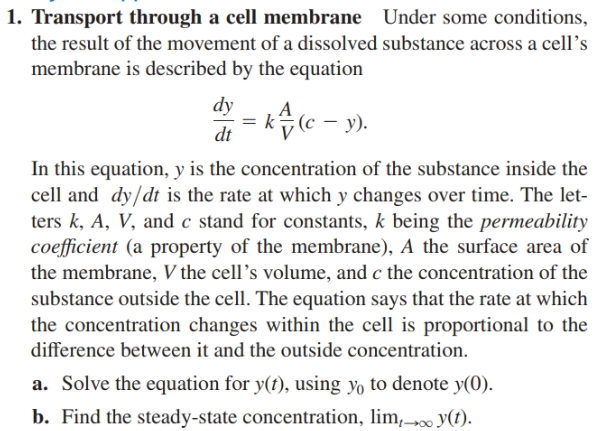1. Transport through a cell membrane Under some conditions, the result of the movement of a dissolved substance across a cell's membrane is described by the equation dy k(c – y). dt In this equation, y is the concentration of the substance inside the cell and dy/dt is the rate at which y changes over time. The let- ters k, A, V, and c stand for constants, k being the permeability coefficient (a property of the membrane), A the surface area of the membrane, V the cell's volume, and c the concentration of the substance outside the cell. The equation says that the rate at which the concentration changes within the cell is proportional to the difference between it and the outside concentration. a. Solve the equation for y(t), using yo to denote y(0). b. Find the steady-state concentration, lim,0 y(t).
1. Transport through a cell membrane Under some conditions, the result of the movement of a dissolved substance across a cell's membrane is described by the equation dy k(c – y). dt In this equation, y is the concentration of the substance inside the cell and dy/dt is the rate at which y changes over time. The let- ters k, A, V, and c stand for constants, k being the permeability coefficient (a property of the membrane), A the surface area of the membrane, V the cell's volume, and c the concentration of the substance outside the cell. The equation says that the rate at which the concentration changes within the cell is proportional to the difference between it and the outside concentration. a. Solve the equation for y(t), using yo to denote y(0). b. Find the steady-state concentration, lim,0 y(t).
Calculus: Early Transcendentals
8th Edition
ISBN:9781285741550
Author:James Stewart
Publisher:James Stewart
Chapter1: Functions And Models
Section: Chapter Questions
Problem 1RCC: (a) What is a function? What are its domain and range? (b) What is the graph of a function? (c) How...
Related questions
Question

Transcribed Image Text:1. Transport through a cell membrane Under some conditions,
the result of the movement of a dissolved substance across a cell's
membrane is described by the equation
dy
k(c – y).
dt
In this equation, y is the concentration of the substance inside the
cell and dy/dt is the rate at which y changes over time. The let-
ters k, A, V, and c stand for constants, k being the permeability
coefficient (a property of the membrane), A the surface area of
the membrane, V the cell's volume, and c the concentration of the
substance outside the cell. The equation says that the rate at which
the concentration changes within the cell is proportional to the
difference between it and the outside concentration.
a. Solve the equation for y(t), using yo to denote y(0).
b. Find the steady-state concentration, lim,0 y(t).
Expert Solution
This question has been solved!
Explore an expertly crafted, step-by-step solution for a thorough understanding of key concepts.
This is a popular solution!
Trending now
This is a popular solution!
Step by step
Solved in 6 steps with 6 images

Recommended textbooks for you

Calculus: Early Transcendentals
Calculus
ISBN:
9781285741550
Author:
James Stewart
Publisher:
Cengage Learning

Thomas' Calculus (14th Edition)
Calculus
ISBN:
9780134438986
Author:
Joel R. Hass, Christopher E. Heil, Maurice D. Weir
Publisher:
PEARSON

Calculus: Early Transcendentals (3rd Edition)
Calculus
ISBN:
9780134763644
Author:
William L. Briggs, Lyle Cochran, Bernard Gillett, Eric Schulz
Publisher:
PEARSON

Calculus: Early Transcendentals
Calculus
ISBN:
9781285741550
Author:
James Stewart
Publisher:
Cengage Learning

Thomas' Calculus (14th Edition)
Calculus
ISBN:
9780134438986
Author:
Joel R. Hass, Christopher E. Heil, Maurice D. Weir
Publisher:
PEARSON

Calculus: Early Transcendentals (3rd Edition)
Calculus
ISBN:
9780134763644
Author:
William L. Briggs, Lyle Cochran, Bernard Gillett, Eric Schulz
Publisher:
PEARSON

Calculus: Early Transcendentals
Calculus
ISBN:
9781319050740
Author:
Jon Rogawski, Colin Adams, Robert Franzosa
Publisher:
W. H. Freeman


Calculus: Early Transcendental Functions
Calculus
ISBN:
9781337552516
Author:
Ron Larson, Bruce H. Edwards
Publisher:
Cengage Learning